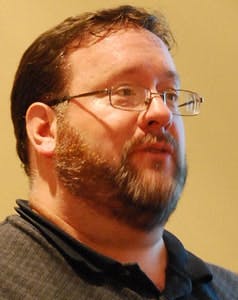Check out ControlGlobal.com on Google+
Since the beginning of automated assembly, the automotive industry has been at the forefront of automation innovation and has led industrial manufacturing into several emerging technologies, including on-machine and mobile technologies, safety and the deployment of EtherNet/IP communication networks, noted Mark Joppru, global director of the automotive and tire business for Rockwell Automation, as he kicked off the Automotive Industry Forum this afternoon at the Automation Fair in Philadelphia.The automotive industry has been operating on an increasingly global level, and where the car manufacturers go, so must their suppliers. "We don't call them suppliers anymore; they're partners," said Peter Daenen, chief program engineer for body construction engineering for Ford South America, who discussed Ford's globalization efforts during the forum. "It's critical that as we go global, they go global with us."
American Axle & Manufacturing (AAM) is a tier-one powertrain supplier that has had to make that move and now has 35 facilities worldwide. "We have gone global to follow the brands around the globe," said Jeff Smith, technology lead at AAM in Detroit.
Smith described his company's move from Interbus to EtherNet/IP in late 2006, which was prompted by increasingly global manufacturing capacity and the need to shake up its controls architecture. It was August, and the company was launching a new assembly system in January. Smith and his team were tasked with deploying a completely revamped controls architecture in just a few months.
The "Other Guys" Win
"I thought we would stay with the current architecture, given the timing. But I had to go through the process. I had to do my due diligence," Smith recalled. "And I'll be darned if the other guys didn't win." The "other guys" were Rockwell Automation and its Logix5000 control system, instead of the mishmash of devices AAM had been using.
Nonetheless, all four assembly systems launched over a four-month period flawlessly, and with only a single controls engineer needed on-site in Silao, Mexico. Though people often present it as such, EtherNet/IP is not a 10-ton elephant, Smith insisted. "It is a controls fieldbus, period. It is not complicated. If you have DeviceNet, and you want to go to EtherNet/IP, it's that easy. It is an enabling fieldbus technology."
Today AAM has in place DLR, CIP Motion, PowerFLEX 755 with and without CIP Motion, RSLogix 5000 and 1756-L61 processors, and has "never looked back," Smith said.
Production has standardized globally on controls, HMI and more. "We provide our suppliers logic references, HMI references," Smith said. "I can walk into any place in American Axle globally, and I know how to use the HMI. I know how to program it; I know how it works and how to fix it."
Along with globalization, economies of scale are forcing standardization across car models, Joppru noted. "And it affects automation," he added. "They want standards and standard plants."
"One Ford" Includes Global Automation Strategy
Ford's system of standardization around the globe is called One Ford, and it applies across 70 existing plants, as well as nine new plants planned for Asia-Pacific. "Ford's been on a journey of transforming itself into a One Ford global company," Daenen said. "That globalization approach applies to all functions, including manufacturing."
Manufacturing is focused on a common set of standards in the Ford Production System (FPS) to build a less standard set of automobiles. It's not a one-size-fits-all approach for its customers, Daenen said, but rather standardizing on parts and techniques to provide more choices, with all vehicle models available with a variety of powertrains. "It's the face of changing market demands," he said. "We have to become more global. While flexibility is key to our ability to deliver products to market faster, in the same process, we need to drive down our investment."
To implement flexibility in major areas of production—the body shop, paint shop and final assembly, as well as some opportunities in powertrain operations—Ford is concentrating on three main pillars: global bill of process and global bill of design, which limit the design and content of a vehicle; and a modularity strategy. "We combine these three, and we are able to get to global product flexibility," Daenen said.
Ford's goal has been to move away from relatively non-flexible lines with asset-intensive tooling systems that can run three models. "We were looking for a much higher level of flexibility," Daenen said. Ford found it with a new line capable of running six or seven models using lighter-duty, more flexible tooling systems.
"Last year about 55% of the body shops were flexible," Daenen detailed. "Our plan is to crank that up to 65% by end of this year. As we launch new plants, mainly in Asia-Pacific, we're supplying flexible body shops."
Ford defines flexibility as 80% of the body tuning not being vehicle-specific, Daenen said. "When the next vehicle comes along, we can run it through with a minimum amount of investment and rework."
Ford is also expanding its use of virtual tools to assess the way it builds vehicles, Daenen said. "By studying the best way to install a seat into a vehicle, you can obviously assess beforehand the potential ergonomic risks or accidents without being on the line, and still deliver quality."
Since implementing virtual tools, Ford has been able to reduce build issues by about 90%, Daenen said. "Investment efficiency is absolutely key, and virtual tools have helped." By leveraging supplier partnerships, globalization and the application of lean, flexible engineering principles, Ford has been able to reduce its investment for new vehicles by about 20%, and by about 50% for new vehicle derivatives.
About the Author
Aaron Hand
Aaron Hand

Leaders relevant to this article:



